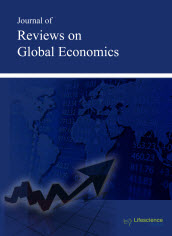jrge
Abstract - The Savings Potential of Sino-Indian Free Trade Agreement within Regional Comprehensive Economic Partnership Initiatives
|
|
Abstract: The ASEAN community as an international institution has proposed to strengthen economic development by widening cooperation with other countries through regionalism. ASEAN has proposed RCEP with six ASEAN FTA partners within the region. There is no FTA yet between some of the non-ASEAN member countries such as India and China. This condition has influenced the conclusion of RCEP because of different interest among the major power countries. This paper has examined the FTA saving potential analysis between India and China as two of the major power countries in the RCEP negotiations. The FTA saving potential of India and China will be analyzed by using ex-ante analysis. India and China are having the different interests of the preferential agreement on the tariff. India has high tariffs barrier to protect its domestic market. Furthermore, India has demanded the other members to liberalize their services market through RCEP negotiation. India and China have been seen as a rivalry from the political point of view. Both countries have the biggest GDP among RCEP member countries. Therefore, India and China participation in RCEP development are essential to be maintained. The economic interdependence between India and China could lead to cooperation through RCEP. The savings potential analysis shows the tariffs that could be negotiated between India and China. India has proposed to dismantle tariff up to 20 years. This paper has calculated the projection of maximum saving potential that includes three scenarios in the calculation: 20 years of dismantling tariff, export growth and utilization rate. RCEP has been developed to build a comprehensive mutual agreement and economic benefit among the members through cooperation. Keywords: China, India, ASEAN, RCEP, political, economy, regionalism, saving potential. |
Abstract - Have Sentiments Influenced Malaysia’s Stock Market Volatility During the 2008 Crisis?
|
|
Abstract: This paper examined the effects of both macro-economic and investor sentiment on the volatility of the Malaysian stock market, during the 2008 global financial crisis. However, as the measurement for investor sentiment is unavailable, we constructed an investor sentiment composite index from a number of proxies, namely; the stock market turnover, number of Initial public offerings (IPO) and its initial returns, advance decline ratio, and consumer sentiment index by employing a strict process of Factor analysis with Principal component analysis’ extraction. By employing Autoregressive Distributive Lags (ARDL) model, we observed the failure of macroeconomic fundamentals to significantly predict the Malaysian stock market’s volatility during the crisis period while investor sentiment was a significant factor that influenced the market. These findings support the notion that investors tend to behave irrationally during crisis periods and these may assist practitioners in formulating specific investment strategies during crucial periods in order to gain abnormal returns. Keywords: Macroeconomic fundamentals, investor sentiment, global financial crisis, volatility, Malaysia stock market. |
Abstract - Econometric Models for Forecasting Innovative Development of the Country
|
|
Abstract: The purpose of this study is to develop models to predict the level of innovative development of countries, as well as to identify the most significant factors influencing innovative development. Keywords: Econometric model, explanatory factors, explained factor, Global Innovation Index, innovative development, regression, forecasting. |
Abstract - Current State and Prospects of Russia – China Trade Development in the BRICS Format
|
|
Abstract: Motivation: The substantiation of the scientific problem and the practical value of the study are determined by the enhanced cooperation of the BRICS countries, in particular the growing weight of Russia and China on the world stage. The main objective of the study: is to analyze the problems of the development of bilateral trade between China and Russia and to provide a statistically proven forecast for this trade for 2019-2020, as well as to develop recommendations for the improvement of bilateral trade relations. Novelty: The author’s statistical model was developed and its testing was presented through confirming the 24-month forecast of bilateral trade between Russia and China. The model involves solving various problems of bilateral trade. Recommendations for improvement of bilateral trade relations are proposed through formation of an investment and innovation model of bilateral trade. Keywords: Key indicators of BRICS countries development, the structure of trade between Russia and China, a forecast of mutual trade development for 2019-2020, an investment and innovation model, trade development prospects. |






















